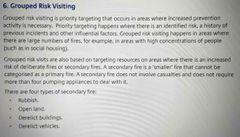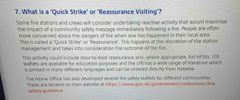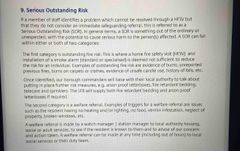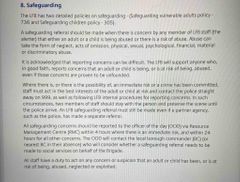![]()
![]()
![]()
Use LEFT and RIGHT arrow keys to navigate between flashcards;
Use UP and DOWN arrow keys to flip the card;
H to show hint;
A reads text to speech;
9 Cards in this Set
- Front
- Back
|
What is community safety? |
Community safety is a core function of every fire and rescue service, including the London fire brigade. The Lfb works to help people stay safe from fire and other emergencies, in the home, at work and across the communities in London. The Lfb works to educate individuals and communities about what they can do to protect themselves from fire. |
|
|
The reasons why we carry out community safety. |
The Lfb has both a statutory and moral obligation to carry out community safety. The fire and rescue act 2004 replaced the fire services act 1947. This change in legislation placed community safety at the top of the fire and rescue authoritys agenda and put a greater emphasis on fire prevention, helping to save more lives and reduce injuries from fire, and to help create safer communities. Particularly for the most vulnerable individuals and communities in our society. We morally do this aswell because it’s the right thing to do, most fires can be prevented when we highlight the hazards in such a way that people remember the message and act upon it. |
|
|
What is our overview of the community safety directorate? |
There primary role is to identify, educate and target those at risk from fire in London. The department carries out extensive research into prevention and risk and uses the findings to inform frontline staff. This influences the way they interact with members of the public and the advice they give. They also specifically work with vulnerable individuals who are a priority to the Lfb. These include but are not limited to, children and young people, those with mobility issues and individuals who cannot escape a fire without assistance, those with mental health issues and other high risk groups. |
|
|
What are the interventions we use to engage with children and young people? |
The education team- provides fire safety education to children in targeted primary and secondary schools within Greater London. All visits are allocated in a risk priority basis. They do work shops about home fire safety as well as reactive sessions concerning the dangers of setting fires and or making hoax calls. Fire cadets- it’s a youth engagement programme which offers people (14-18) to work alongside the Lfb and gain a recognised qualification and life skills they can use in the work place. The scheme benefits young people who have difficulty at school, have low self esteem and a lack of confidence, they are at risk of anti social behaviour, they have little or no direction in life, have been excluded socially or educationally. Crossfire- it’s a multi agency community engagement project that’s designed to reduce hoax calls, deliberate fires and anti social behaviour through education and direct partnership working. It delivers a range of educational programs to primary and secondary schools, pupil referral units, collages, youth clubs and other community groups. The various modules within its program, offered by way of its multi agency approach, enable crossfire to tailor a bespoke input most suited to deal with local issues. As well as engaging with the children of the borough, it also includes their parents or guardians. Life project (local intervention fire education) project. - it is a 5 day intensive course. It’s run by the drs and operational staff at fire stations across London. It’s for young people aged between 14-17 who fit the criteria it gives them the opportunity to build on existing skills and learn new ones. The course is based on a fire fighters role and participants take part in a range of activities including using ladders, hose running skills, casualty rescue techniques, wearing breathing apparatus and team building tasks. As well as fire safety information and fire prevention and consequences of actions. There will be a pass out parade at the end where the children can demonstrate their skills to their families and carers and each child gets a portfolio with certificates and assessments. The program was introduced in tower hamlets in 2002 as a response to anti social behaviour against fire fighters. Juvenile firesetters intervention scheme- this scheme works with children and young people who demonstrate any type of fire setting behaviour or are fascinated by fire. The scheme offers one to one fire safety and education and advice to the child and their parents/carers to change their behaviour. |
|
|
What is a fire safety visit?what |
It’s where a fire fighter will engage with residents and educate them in hazards and risks which people may encounter in their home, to reduce the likelihood of having a fire. By offering practical advice on fire safety in the home, and what to do in the event of a fire breaking out, including the creation of an escape plan, firefighters help to change individuals and communities behaviours. They also fit smoke alarms in all areas of risk. |
|
|
What is meant by grouped risk visiting? |

Back (Definition)
|
|
|
What is a ‘quick strike’ or ‘reassurance visiting’? |

Back (Definition) |
|
|
What is a serious outstanding risk and how to make a welfare referral. |

Back (Definition) |
|
|
What is a safe guarding referral and how to make one? |

Back (Definition) |

